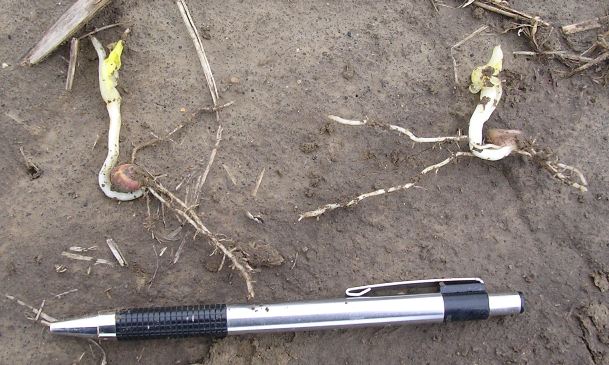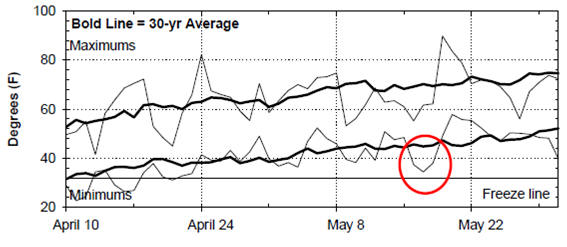June 1, 2009
Field Crops 28.42 - 64
Corn Unfurling Underground:
An observation involving low temperatures
Joe Lauer, Corn Agronomist
It has been relatively quiet for corn problems in Wisconsin so far. Farmers are
struggling with some late-planting in IL, IN, MI, and OH. Also, eastern WI was somewhat
late with planting, but the last couple of weeks have seen nearly the entire state
complete planting. Emergence has been good. Jerry Clark (Agent in Chippewa County
of NC WI) has reported a case where only Apron® was used and a general seed fungicide
(Maxim® or Captan®) was not used with the result being a poor stand. I observed
in my travels to northwestern WI that corn growth and development was similar to
southern WI. Northwestern WI was somewhat dry the week of May 31.
About the only problem reports we have so far are some stand issues with ~10 to
15% of corn plants unfurling underground (Figure 1). The area most affected is bounded
by the towns of Cambridge, Janesville, Dodgeville and Madison. Greg Andrews (Agent
in Pierce County of NW WI) has reported a similar issue. It seems to be related
to planting dates around May 4. Low lying fields are most affected. No herbicide
or hybrid pattern is observed. This is not an issue for yield, since stand with
10-15% plant death are still within 5% of maximum yield. If stand loss increases
to 25% then we may consider some management option if we can replant early enough.

Figure 1. Corn unfurling underground. Photo by Eric Birschbach of Ag Site Crop
Consulting, LLC.
Corn unfurling underground can be due to:
- genetic differences (Moll et al., 1969; Tapper and Nevins, 1974)
- compaction or soil crusting (Tapper and Nevins, 1974),
- extended exposure to acetamide/acetanilide herbicides under cool wet conditions
has been reported by numerous agronomists. Examples include acetochlor (Surpass®,
Harness® , TopNotch® , FulTime®, Field Master®,), alachlor (Bullet®, Lasso® and
Lasso II®), metolachlor (Dual®), propachlor (Ramrod®, Bexton®) dimethanit (Frontier®),
- may be due to extended cool wet conditions alone (Buckle and Grant, 1974;
Nielsen, 2009).
Other observations that are not as well documented include premature exposure to
light in cloddy soils, planting too deep, and combinations of several of these factors.
This year the likely cause is cool temperatures in combination with soil crusting.
On May 17 we recorded at Arlington a low temperature of 34 F (Figure 2). It takes
125 GDUs to have the corn crop emerge. Working backwards we would have accumulated
90-100 GDUs on May 17 for May 4 planting dates. The coleoptile would have been right
at the soil surface. This observation does not provide direct evidence of a cause
for underground unfurling only an association.

Figure 2. Maximum and minimum temperatures at Arlington, WI. Data source is
AWON at http://www.soils.wisc.edu/wimnext/awon/awon.html.
Management options for underground unfurling are few and usually not satisfactory.
Rotary hoeing to break a soil crust and control weeds is often too late to do any
good. The best course of action is to evaluate the stand using the guidelines in
Corn Replanting or Late-Planting Decisions
(UWEX Bulletin A3353).
References
Buckle, J.A., and P.M. Grant. 1974. Effects of soil temperature on plumule growth
and seedling emergence of maize (Zea mays L.). Rhodesian Journal of Agricultural
Research 12:149-161.
Moll, R.H., C.S. Levings, III, and C.W. Stuber. 1969. Genetic Variation in Maize
Coleoptile Growth and its Relationship to the Auxin Regulatory System. Crop Sci
9:262-264.
Nielsen, R. 2009. Corkscrewed corn seedlings [Online]. Available at
http://www.agry.purdue.edu/Ext/corn/news/timeless/Corkscrews.html (accessed
13 June 2009; verified 13 June 2009).
Tapper, D.C., and D. Nevins. 1974. Morphological Basis for Poor Emergence in Inbred
Oh43 Corn. Crop Sci 14:581-584.